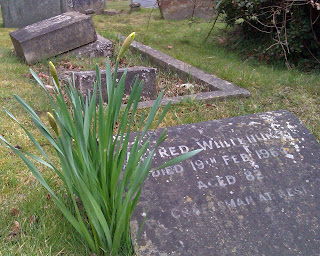| Not the best view you will ever see of a train on the Bluebell Railway's Hill Place Viaduct |
| Works plate from Fenchurch, the oldest railway locomotive continuously in service in Britain |
Francis left Hill Place in around 1896, when the Blount family of Imberhorne Manor purchased the freehold to farm it with their own staff, increasing revenue without increasing costs, and avoiding the fate of many estates in the agricultural depression of the late Victorian years. He went to farm as a tenant of the Ford Manor estate in Dormansland, until he retired to the village a couple of years before his death in 1926.
| My great-great grandfather's last farm |
With this connection, I was keen to catch a shot when the Bluebell Railway started their service to East Grinstead on March 23rd. My plan was scuttled by unseasonable weather between my home and East Grinstead. So, I travelled a couple of weeks later, following the Medway from Maidstone, where I had watched the Isthmian League Cup Final, to its source, taking the picturesque Medway Valley Line to Tonbridge, then, in a reverse of the East Grinstead Song, the 291 bus from Tunbridge Wells.
When Channel 4 made a documentary in 1985 called God Rot Tunbridge Wells, about the composer Handel, the title based on his reported comment after a bad reception at a concert in the town, my mother remarked what a sensible man Handel must have been - she could not stand the place. I found it quite pleasant, but when I had checked the time on the Millennium Clock ...
... looked round the museum and the Church of King Charles the Martyr (attended by Princess Victoria before she became Queen), and perambulated through the Pantiles (originally surfaced with tiles shaped in pans) ...
... I felt I had exhausted all it had to offer the casual visitor.
The Bluebell were still running their opening gala service, with a train up and down the line about every hour and a quarter, so I did not have long to wait.
The view from the train includes some of my great-great-grandfather's fields, although not the farmhouse, hidden from view by more recent buildings.
Turning back to our first picture, I would have found a better place to stand to get the train in if I had paid attention to a picture from earlier in the day. For some reason I thought in front of the tree peeping up from below the parapet might be a good vantage point.
| Garden Wood Road from the Viaduct |
We can see how cold the spring has been, we are well into April, but the daffodils (remnants of those planted in 1964 - I keep thinking about planting more, but usually at the wrong time of year) have still to bloom.
There are some more pictures from the trip here.
